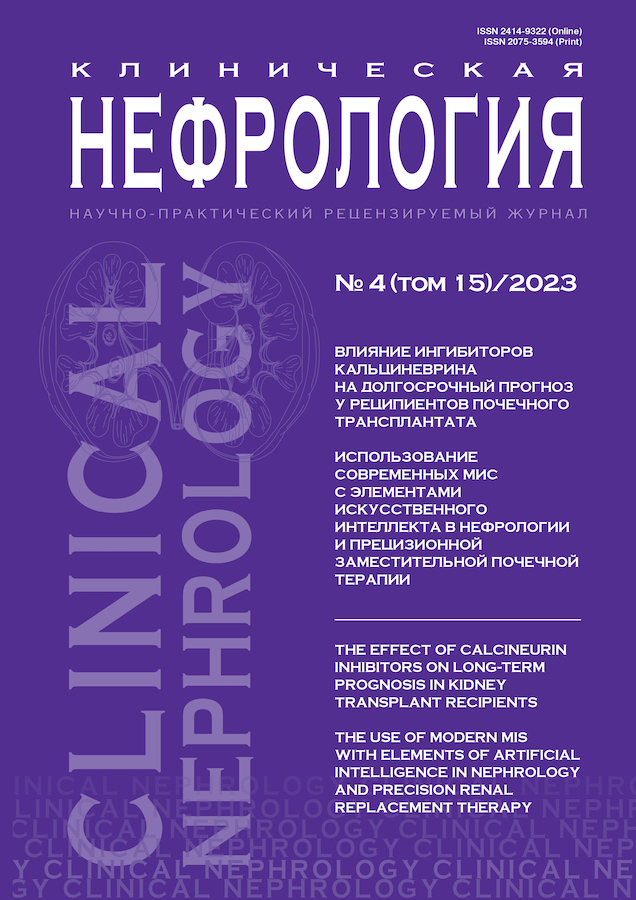Diagnostic value of echocardiography parameters for assessing intravascular status in nephrotic syndrome in children
- Авторлар: Mamatkulov B.B.1,2, Mamatkulov I.B.1
-
Мекемелер:
- Tashkent Pediatric Medical Institute
- National Medical Children’s Center
- Шығарылым: Том 15, № 4 (2023)
- Беттер: 17-20
- Бөлім: Original Articles
- URL: https://journals.eco-vector.com/2075-3594/article/view/630883
- DOI: https://doi.org/10.18565/nephrology.2023.4.17-20
- ID: 630883
Дәйексөз келтіру
Аннотация
Background. Nephrotic syndrome (NS) is a common kidney disease in childhood. The disease is characterized by massive proteinuria, hypoalbuminemia and edema. Edema is one of the main characteristics of NS, but its pathogenesis is still not fully understood.
Objective. Assessment of the state of intravascular volume using echocardiography parameters.
Material and methods. The study included 80 children with different types of NS, aged from 2 to 18 years. Intravascular volume status was assessed by determining the inferior vena cava index, inferior vena cava contractility index, left atrium diameter and aortic annulus diameter.
Results. In 28 patients, the mean index of the inferior vena cava contractility was 11.94±7.80%, the mean diameter of the left atrium was 22.09±12.42 mm/m2, the diameter of the aortic ring was 25.34±5.64 mm. In the remaining 52 patients, the mean index of the inferior vena cava contractility was 13.98±5.21%, the mean diameter of the left atrium was 27.78±6.99 mm/m2, the diameter of the aortic ring was 20.23±3.72 mm.
Conclusion. Echocardiographic parameters such as inferior vena cava contractility index, left atrial diameter, and aortic annulus diameter were the best predictors of body fluid volume status in NS and were a useful guide for assessing intravascular volume status in children. This study also showed that a wide range of patients with NS are normovolemic or hypervolemic.
Негізгі сөздер
Толық мәтін
Авторлар туралы
Bakhrom Mamatkulov
Tashkent Pediatric Medical Institute; National Medical Children’s Center
Хат алмасуға жауапты Автор.
Email: bahrom-mamatkulov@mail.ru
ORCID iD: 0000-0003-1921-4458
Can. Sci. (Med.), Associate Professor at the Department of Emergency Medicine, Tashkent Pediatric Medical Institute
Өзбекстан, Tashkent; TashkentIkhtiyor Mamatkulov
Tashkent Pediatric Medical Institute
Email: mikhtiyor77@mail.ru
ORCID iD: 0000-0003-4053-4544
Can. Sci. (Med.), Associate Professor at the Department of Pediatric Anesthesiology and Reanimatology, Tashkent Pediatric Medical Institute
Ресей, TashkentӘдебиет тізімі
- Doucet A., Favre G., Deschenes G. Molecular mechanism of edema formation in nephrotic syndrome: therapeutic implications. Pediatr. Nephrol. 2007;22(12):1983–90. doi: 10.1007/s00467-007-0521-3. [Epub 2007 Jun 7].
- Siddal E.C., Radhakrishnan J. The pathophysiology of edema formation in the nephrotic syndrome. Kidney Int. 2012;82(6):635–42. doi: 10.1038/ki.2012.180. [Epub 2012 Jun 20].
- Schrier R.W., Fassett R.G. A critique of the overall hypothesis of sodium and water retention in the nephrotic syndrome. Kidney Int. 1998;53(5):1111–17. doi: 10.1046/j.1523-1755.1998.00864.x.
- Dorhout Mees E.J., Geers A.B., Koomans H.A. Blood volume and sodium retention in the nephrotic syndrome: a controversial pathophysiological concept. Nephron. 1984;36(4):201–11. doi: 10.1159/000183155.
- Ichikawa I., Rennke H.G., Hoyer J.R., et al. Role for intrarenal mechanisms in the impaired salt excretion of experimental nephrotic syndrome. J. Clin. Invest. 1983;71(1):91–103. doi: 10.1172/jci110756.
- Jaeger J.Q., Mehta R.L. Assessment of dry weight in hemodialysis: an overview. J. Am. Soc. Nephrol. 1999;10(2):392–403. doi: 10.1681/ASN.V102392.
- Kaptein M.J., Kaptein E.M. Focused real-time ultrasonography for nephrologists. Int. J. Nephrol. 2017;2017:3756857. doi: 10.1155/2017/3756857. [Epub 2017 Feb2].
- Blehar D.J., Resop D., Chin B., et al. Inferior vena cava displacement during respirophasic ultrasound imaging. Crit. Ultrasound J. 2012;4(1):18. doi: 10.1186/2036-7902-4-18.
- Ozdemir K., Mir M.S., Dincel N., et al. Bioimpedance for assessing volume status in children with nephrotic syndrome. Turk. J. Med. Sci. 2015;45:339–44.
- Nalcacioglu H., Ozkaya O., Baysal K., et al. The role of bioelectrical impedance analysis, NT-ProBNP and inferior vena cava sonography in the assessment of body fluid volume in children with nephrotic syndrome. Nefrol. 2018;38(1):48–56. doi: 10.1016/j.nefro.2017.04.003 [Epub 2017 Jul 25].
Қосымша файлдар







